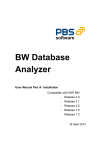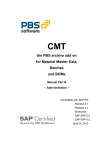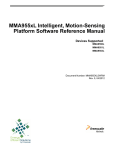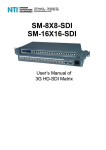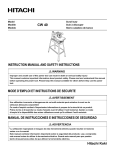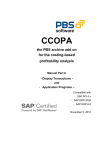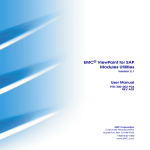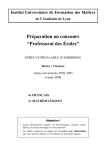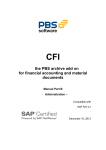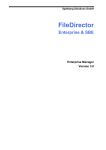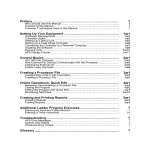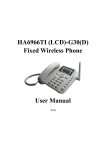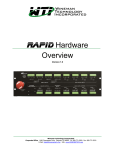Download PBS archive add ons - Manual Part A - Installation -
Transcript
PBS archive add ons Manual Part A - Installation - Compatible with SAP R/3 4.x SAP ERP 2004 SAP ERP 6.0 SAP ERP 6.17 October 29, 2015 PBS archive add ons - Installation - © 2000 - 2015 PBS Software GmbH Schwanheimer Strasse 144a 64625 Bensheim, Germany Phone: +49 - 6251 - 174 0 Fax: +49 - 6251 - 174 174 Email: [email protected] Internet: www.pbs-software.com PBS archive add ons® is a registered trademark of PBS Software GmbH, Bensheim. SAP, R/3, SAP ERP, SAP NetWeaver, ABAP and others are registered trademarks of SAP SE in Germany and in several other countries. Acrobat Reader is a registered trademark of Adobe Systems Incorporated. 2 PBS archive add ons - Installation - Introduction to the PBS ILM Concept Information Lifecycle Management Information Lifecycle Management (ILM) means the administration of information related to the time when it is used, taking into account its total costs and compliance. A conclusive, efficient ILM concept must, as a result, control data growth, manage retention rules, and also ensure compliant data storage. Furthermore, an easy access to archived data is decisive and, for example, its transfer during internal and external audits. PBS ILM Concept PBS software provides existing SAP customers extensive solutions to put into practice the requirements that were described above for a stringent and successful ILM concept. PBS is considered as an expert for complex, integrated data accesses to archived and database data and meanwhile, also to data that is located on decommissioned SAP systems. In addition to classical SAP data archiving, SAP BI-specific nearline storage is also supported. PBS archive add ons® PBS archive add ons always rely on SAP archiving having been carried out successfully. This is the basis for a permanently high-performing SAP system. In principle, you can indeed retain posted documents in the SAP database for a very long time due to a large database capacity. Depending on the document volume, this may result, however, in massive performance losses and, sooner or later, heavily increasing operation costs. The daily backup becomes difficult for large data stocks, for example. A convenient display and evaluation of archived transaction data – as the SAP user is used to for database data – can often only be carried out in a very restricted manner using SAP standard means depending on the application module. This is particularly the case for large archive data stocks. The PBS archive add ons can be used here. They can be provided for nearly all SAP modules and release levels, and start with a "C" (for Complete) in their description. For example, PBS archive add on CCOPA for the SAP module COPA. Using the PBS archive add ons you can quickly and easily access your archived data even after data archiving during your day-to-day business. The unrestricted data access is realized by an intelligent indexing concept. It extends the SAP archive infrastructure components and integrates itself optimally with SAP archiving. Archive data that has been indexed can still be provided after a release upgrade 3 PBS archive add ons - Installation - immediately, without restrictions, and without migration effort. The PBS archive index is stored in sequential files of the SAP file system in the same way as the SAP archive data. Afterwards, you can access the archive data online via the familiar transactions. The SAP user can display the data from the SAP database and the archive data simultaneously via the PBS archive add on index. For the user, it seems as though the archived data is still in the SAP database. The deep integration of the PBS transactions also enables direct navigation to subsequent and previous documents both within the indexed SAP module as well as to linked documents from other SAP modules. This applies not only for resident but also without restrictions for archived data. The benefit for the user increases the more PBS archive add ons are used. The potential benefits of the ILM concept raises substantially if you take into account the savings that result from the SAP mirror systems. There are usually at least two of them meaning that the saved disk storage can be tripled by performing data archiving. Thus, time is saved for the data backup. 4 PBS archive add ons - Installation - Table of Contents 1 Introduction 8 2 PBS Concept for Software Deliveries 9 2.1 Final Release 9 3 4 5 2.2 Customer Patch 10 2.3 Utility Transport 11 Delivery 12 3.1 Components for the SAP system: Final Release 14 3.2 Customer Patch (Updates and Subsequent Transports) 15 Installation from SAP R/3 Enterprise 16 4.1 PBS Namespace 17 4.2 Initial Installation 19 4.3 The Installation of Updates 22 4.4 Upgrade to higher releases 23 4.5 Installation Check 24 4.5.1 SAINT 24 4.5.2 SPAM 25 4.5.3 Transport Logs 25 4.6 Information Lifecycle Management 26 4.7 Transport to the Production System 27 4.8 Summary of the Installation 28 4.9 Uninstall 28 Installation into the SAP system up to 4.6C 29 5.1 PBS Namespaces from Rel. 4.0 30 5.2 Initial Installation 31 5.3 Installation of Updates (Customer Patch) 33 5.4 Upgrade to Higher Releases 34 5.5 Supervision of the Installed Transport 35 5.6 PBS Transport History 37 5.7 Transport into the Production System 38 5.8 Summary of the Installation 41 5 PBS archive add ons - Installation - 5.9 Peculiarities under Operating System AS/400 42 6 Customer-specific Enhancements and Modifications 43 7 Module-Specific Features 44 7.1 Necessary Authorizations 44 7.2 Preassignment Research Source (from SAP Enterprise Release) 44 7.3 Data extract administration (from SAP Enterprise Release) 46 7.3.1 Function overview 46 7.3.2 Maintain storage nodes 48 7.3.3 Administration of extract files 52 7.3.4 Connection to a Content Repository 54 7.4 PBS archive add on CFI 56 7.4.1 Target Client for Installation Procedure 56 7.4.2 Notes on the SAP EURO Functionality 56 7.4.3 Connection to FI-AA (Asset Accounting) 56 7.4.4 Connection of the Legal Case Management to the PBS archive add on CFI 61 7.4.5 Regeneration /PBS/RFUMSV00 from 4.0 7.4.6 Transfer of dynpro variants to the coding block (from ECC 5.0) 62 7.4.7 Transfer of Selection/List Variants from the SAP Standard 63 7.4.8 User Dependent Default Values SAP Memory 64 7.4.9 Suppression Message Output 65 61 7.4.10 Runtime Analysis 66 7.4.11 BW Data Extraction 67 7.5 PBS archive add on CSD 71 7.5.1 Zconfigurator 71 7.5.2 Administration Table 71 7.6 PBS archive add on CMM 72 7.6.1 Notes for SAP Release 3.0F 72 7.6.2 SAP Systems Without EURO Package 72 7.6.3 Migration arch. order requisitions (4.x) 72 7.7 PBS archive add on CPP 73 7.7.1 To Do after Put to Enterprise Release 73 7.7.2 New Program Names 73 7.8 PBS archive add on CCO 74 6 PBS archive add ons 7.8.1 - Installation - BW Data extraction 7.9 PBS archive add on CCMD/CVMD 7.9.1 Complete Functionality 7.10 PBS SE16_PERSONAL 7.10.1 Installation of PBS authorization objects for date checks 7.11 PBS DART Concept 8 74 76 76 77 77 78 7.11.1 SAP DART Concept 78 7.11.2 PBS DART Concept 79 7.11.3 Password 79 Documentation 80 8.1 Display of PBS Documentation in the SAP System via Intranet or the local network 82 9 Optimizing the Indexing Process when storing Files via SAP ArchiveLink 83 7 PBS archive add ons - Installation - 1 Introduction The PBS archive add ons are constructed in modular form and cover the application modules FI, SD, MM, CO etc. with a special program package for exactly this application. You can easily see from the name which PBS archive add on belongs to which SAP module: CFI, CSD, CMM, CCO etc.. All PBS archive add ons can be easily installed in the SAP system via the transport utility "tp" of SAP SE up to Release 4.6C and with SAP transactions SAINT and SPAM in the Enterprise Release. This installation guide should help you to simplify the successful installation of the PBS archive add on(s). Please read our recommendations on the installation of the PBS archive add ons step for step. The general part, describing the same tasks for all PBS archive add ons, is followed by a chapter with module-specific recommendations. Please read the hints listed for your module before installing the PBS archive add on. The modular user manual of each PBS archive add on is composed of the partial manuals: - Part A: Installation - Part B: Administration, Archive Construction and -Maintenance - Part C: Application Programs / -Transactions - Part D: Module-Specific Additions (optional) - Part E: Conversion Tool (Adaptation of customer ABAPs) Should you have questions regarding the installation of the PBS archive add ons or if you have problems when installing the software please call directly the Service Hotline of PBS Software GmbH: Phone: +49 - 6251 - 174 110 Fax: +49 - 6251 - 174 174 email: [email protected] Release Compatibility The PBS archive add ons discussed in this manual run with the basis programs of SAP SE, releases R/3 4.0, 4.5, 4.6, Enterprise, SAP ERP 2004, ERP 6.0, ERP 6.17. 8 PBS archive add ons - Installation - 2 PBS Concept for Software Deliveries PBS Software GmbH now supplies the PBS archive add ons within a unified release strategy. This means for you, the PBS customer, a facilitated administration of the different PBS archive add on versions and an easier installation of updates and corrections. Each delivery contains a "Final Release" and, if necessary, a "Customer Patch" and a utility package. Please follow the hints below to install the components in the right order! 2.1 Final Release The "Final Release" of a PBS archive add on is a complete and extensively tested program package for the corresponding PBS module (CFI, CSD, CMM, CCO,...). Such a "Final Release" is always created for each different SAP release (3.0, 3.1, 4.0B, ...). A "Final Release" contains all components described in the user manual (parts A, B, C) of the corresponding PBS module and can run on its own. When installing a PBS archive add on for the first time, the "Final Release" must be installed first! From the Enterprise Release an Installation Package (IP) or Upgrade Package (UP) is supplied for each module as Final Release. The only exception is the first Final Release for which only the Installation Package is supplied. Installation and Upgrade Package contain the same objects with the same development level. Therefore, only one of both packages is always required. For the initial installation of each PBS archive add on or for an update the current Installation Package should always be installed after changing the SAP release. However, during an upgrade of the PBS software, the Upgrade Package should be installed within the same SAP release. From the SAP Enterprise Release the PBS Utilities have to be installed or updated before the PBS modules are installed or updated! 9 PBS archive add ons 2.2 - Installation - Customer Patch Having supplied a "Final Release" for a PBS archive add on, improvements, corrections and additions of the different modules are produced within the PBS development strategy. To provide the users of the PBS archive add ons with these news in an easy way, for each "Final Release" so-called "Customer Patches" are supplied. The "Customer Patches" are numbered in chronological order. Each current "Customer Patch" up to release 4.6C contains all improvements, corrections and additions since the delivery of the corresponding "Final Release". Therefore, you do not have to install more than two transports for each PBS archive add on. From the Enterprise Release the customer patches are no longer provided cumulatively as support packages, but only contain the modifications since the creation of the previous customer patch. Therefore, all support packages have to be imported which are supplied with the current final release and which have not been installed in the system yet. If you have once purchased and installed a PBS archive add on, you can ask for new "Customer Patches" within certain periods or if necessary (either by phone or Internet). You will only have to import these relatively small correction transports in order to update your PBS archive add on. A "Customer Patch" is to be installed always after the installation of the "Final Release". 10 PBS archive add ons 2.3 - Installation - Utility Transport The utility transport is a transport with objects that can be applied in two or more PBS archive add ons and represents a complete PBS application functionality like the PBS translation tool, the PBS Archive Browser and the PBS Conversion Tool. The latest utility transport order including the documentation (Translation Tool, Archive Browser, and Conversion Tool) is contained in each FTP download or on each CD. For a trouble-free function of each PBS archive add on the latest version of the utility transport should be installed after having installed the PBS archive add on. It does not matter if it is a first installation or an update. IMPORTANT! From the SAP Enterprise Release the objects of the PBS utilities were consolidated and added by a function (see chapter 6.1). Furthermore, the transports are created with the SAP Add-On Assembly Kit and Support Packages will be provided for the PBS Utilities. These changes require another installation sequence: 1. (Single) import of the namespace transport 2. PBS Utilities a) Final Release (Installation Package or Upgrade Package) b) Customer Patches (Support Packages) 3. PBS archive add on(s) a) Final Release (Installation Package or Upgrade Package) b) Customer Patches (Support Packages) Up to release 4.6C the utility transport has to be implemented after the installation of the Final Release and/or Customer Patch. 11 PBS archive add ons - Installation - 3 Delivery The programs and documentations of the PBS archive add ons are supplied as FTP download or on CD ROM. The delivery of each module contains: Transport files with all required programs and data files (tables, table entries, data definitions etc.). File directory: \R3 or ECC with the sub-directories \final for the transports of the Final Release and \patch for those of the Customer Patch. R/2 PC-Download files with the necessary migration programs and components for the migration of archived R/2 data to R/3 (file directory \R2). User manuals and documentations in German and English (file directory \docu with the sub-directories \German and \English). The documentation files are supplied in the PDFformat and can be read with the Acrobat-Reader. For each module you have ordered a directory exists with the abbreviation of the name of the PBS archive add on (e.g.: CFI) as well as a reference number referring to the SAP release in which the PBS archive add on can be used (e.g.: 40all for all SAP R/3 4.0x releases). Some modules have special sub-directories; please see the module-specific hints in this installation manual regarding the description of these sub-directories. 12 PBS archive add ons Example: Diagram 1: Delivery Structure of PBS archive add on CSD - Installation - 13 PBS archive add ons - Installation - 3.1 Components for the SAP system: Final Release The data objects supplied in the different modules within the Final Release (see previous chapter 2.1) are listed in an object list which is contained as text file in the sub-directory /R3/ or ECC for the corresponding PBS archive add ons. Please review the list of the module to be installed before the transport into your SAP system, should it be possible that your system contains transport components of the same name. From R/3 release 4.0, PBS has an own namespace for the specific data objects of the PBS archive add ons so that no naming collisions should occur. The namespace must be defined before the installation of the PBS archive add on (see chapter 4.1 and 5.1 respectively). 14 PBS archive add ons - Installation - 3.2 Customer Patch (Updates and Subsequent Transports) If you receive a subsequent transport (Customer Patch, see previous chapter 2.2) for a PBS archive add on which is already installed and where you already have carried out customer-specific modifications, we recommend for safety reasons, to copy all changed objects under another name before the import. After the installation of the new Customer Patch you can update the changes in the newly installed objects. From SAP Enterprise Release a previous backup is no longer required, as all customer-specific modifications can be compared using the SAP transactions spau and spdd during the import of new transports. A precondition is that you use the modification assistant for entering modifications. Important: Backup the changes you have made in customizing tables which concern to PBS objects (e.g.: path settings of the PBS archiving objects). The installation of patches or final releases can overwrite your changes! From SAP Enterprise Release you can compare the modifications using the SAP transactions spau and spdd. 15 PBS archive add ons - Installation - 4 Installation from SAP R/3 Enterprise The SAP Add-On Assembly Kit (AAK) is used to create the PBS archive add ons from Enterprise Release. The final release of an add on is delivered in an OCS package named Add-On Installation Package (AOI) and Add-On Upgrade Package (AOU) respectively. The import of this package can be made with SAP transaction SAINT. Customer patches have the package type Add-On Support Package and is imported into the SAP system using transaction SPAM. See more details in the following chapters. If you have an SAP system release 4.6C or lower, see chapter 5 for all installation details. Storage of Software Packages Please retain the software packages on a permanent basis after downloading as you will require them again for specific administrative tasks in your SAP system for example, when you install new languages. SAP Put Level and Hot Packages PBS always develops the PBS archive add ons based on the current SAP Put Level, supplemented with the latest available hot packages. PBS attempts to keep all modules downward compatible to the corresponding hot packages. However, in some cases conflicts and related problems may occur when installing respectively running certain PBS programs due to different hot package levels (Customer <> PBS). Should you be faced with such a situation please contact as soon as possible the PBS Service Hotline so that the problems can be solved soon. 16 PBS archive add ons 4.1 - Installation - PBS Namespace Before you can install the Enterprise Packages for the PBS utilities and the first PBS module, you have to import the installation package for the namespace /PBS/. All objects of the PBS archive add ons and the PBS utilities are within this namespace and begin with /PBS/. Use SAP transaction SAINT to import the installation package PBS_NSP_IP_1.sar. This package is in the directory Utilities\47all\R3\Namespc. You should be logged on in client 000 for this transaction! Please note: The installation package PBS_NSP_IP_1.sar has to be imported even if the namespace already exists in your system due to the transfer from an older SAP release level!. Then all necessary definitions are available in the system to use the Modification Assistant. It is also checked in the upgrade packages of the utilities whether this package exists. The package PBS_NSP_IP_1.sar has to be imported only once; for further imports of other PBS modules you can start with the installation of the current utilities packages at once. Copy this package from the delivery in a directory in which you can access with SAINT. Call the following menu option in the transaction SAINT Installation Package – Load packages – From the front end Choose the directory in which you wish to copy the files supplied in the selection screen Select CAR/SAR archive'. After having opened the file continue the installation in SAINT by selecting the button Continue. The procedure corresponds to the description for the import of an installation package in chapter 4.2. 17 PBS archive add ons - Installation - After the import of the package PBS_NSP_IP_1.sar you can display the PBS namespace screen with transaction SE03 selecting Administration – Display/Change Namespaces. The detailed view of the entry /PBS/ should be as follows: Diagram 2: Display of the PBS namespace with SE03 You need the repair license if you intend to define own modifications in the PBS programs. As the namespace role for the PBS namespace has the entry C in your system, the modification assistant is called automatically in case of any changes in the PBS programs - for example with transaction SE38 -. Using the transaction SPAU and SPDD you are able to execute a modification comparison after having imported the PBS Support Package at a later date. 18 PBS archive add ons 4.2 - Installation - Initial Installation The PBS Utilities and the Final Release of a module are in the subdirectory of the R/3 packages or ECC packages (for example \CCO\50all\R3\final or \CCO\47all\ECC\final) in the delivery. The corresponding directory for CCO 4.7 has for example the following content: Diagram 3: Installation / Upgrade package 3 for the module CCO The file PBS_CCO_IP_3.sar is the Add-On installation package for the module CCO. This package should be imported during the first installation of CCO 4.7 on your SAP system, even if CCO was already installed in previous releases per tp in this system. Then PBS_CCO_UP_3.sar should not be installed. PBS_CCO_UP_3.sar is the Add-On Upgrade Package. This package should be installed if a CCO Package had already been installed earlier in this system, for example PBS_CCO_IP_1.sar. As already explained in the previous paragraph, you do not need to import PBS_CCO_IP_3.sar in addition as both packages contain the same objects. The package PBS_CCO_IP_3.sar and PBS_CCO_UP_3.sar respectively can be imported directly with transaction SAINT. Please remember: First import the installation package PBS_NSP_IP_1.sar to set up the PBS namespace, if it has not been made yet. Import the current installation package or upgrade package or support package of the PBS utilities before each import of a module package, if it has not been installed in your system yet. The procedure to install the package PBS_NSP_IP_1.sar or the package for the PBS utilities corresponds to the installation of a module which is described in the following. 19 PBS archive add ons - Installation - Import with transaction SAINT The import of an installation package can be made from any directory with transaction SAINT. Please note that you always install the latest version of SPAM/SAINT in your SAP system! You should be logged on in client 000 for the installation! Call the transaction SAINT and load the packages into the SAP system with the menu options Installation Package – Load packages – From the front end. Diagram 4: Load of the Add-On installation package with SAINT After marking the package to be installed, select the button Öffnen (Open) and then the button Dekomprimieren (Decompress) in the following screen. Then you can continue the installation by selecting button "Start". 20 PBS archive add ons - Installation - Diagram 5: Installation of the Add-On installation package with SAINT Mark the package to be installed and install it by selecting button Continue. Follow all instructions so that the package is displayed as installed in your system. In the upper list the utilities and CCO are displayed as installed in the system. Creation of the PBS-specific file path In order to be able to store the flat files of the PBS archive add on separately from other data, you must create for some modules (CFI, CSD and CMM in the SAP release R/3 Enterprise without Unicode) a physical path directly in the file system of the SAP system. PBS recommends to create an own file directory like ".../pbs/cfi/" for each PBS archive add on you use. All other PBS archive add on modules can address logical path names (in analogy to SAP ADK). In this case, you may eventually omit the creation of an own physical path. The installation of the Final Release has now been finished. 21 PBS archive add ons 4.3 - Installation - The Installation of Updates Updates are supplied in two different transport types, depending on the update type – if it is a final release or a new customer patch: upgrade package (UP) support package (SP) A new Final Release is supplied as an upgrade package and is imported with transaction SAINT analogue to the installation package. Depending on the update level, a current Customer Patch (see chapters 2 and 3) may exist as a Support Package for a Final Release of a PBS archive add on. This Customer Patch must be installed after the installation of the Final Release! As the Support Packages are no longer provided cumulatively from the Enterprise Release, they have to be imported one after another in ascending order. Call transaction SPAM in client 000 for the import of the support package and load the package analogue to the transaction SAINT. Then the installation is made by selecting menu option Support package – Import queue. If you have made modifications in the namespace /PBS/, you will have the possibility to compare them with transactions SPAU and SPDD which you can call within the import process. After the installation of a Customer Patch the complete installation of a PBS archive add on has been finished. Please see the module-specific notes in chapter 6! 22 PBS archive add ons 4.4 - Installation - Upgrade to higher releases During the upgrade of the SAP System to a higher release the PBS archive add ons remain in the system. However, for higher releases proceed as for a new installation. This also applies for an upgrade from SAP R/3 Enterprise to mySAP ERP 2004 with ECC 5.0 or higher releases. During the upgrade of your SAP system you will be requested to choose one of the options displayed for the installed PBS archive add ons, such as Delete, Keep or Keep (with vendor key). Choose the option Keep and if this option cannot be selected, choose Keep (with vendor key). You will need to contact our hotline to obtain the vendor key. Although the PBS archive add ons remain unchanged in the system, a new installation is required for a higher SAP release, starting with the package PBS_NSP_IP_1.sar of the respective release level. For a new installation you should also install the Installation Package for the PBS utilities and the modules. If you want to upgrade within the same SAP release level, you will need to install the current Upgrade Package. A new setup of the archive data is not usually required. 23 PBS archive add ons 4.5 - Installation - Installation Check 4.5.1 SAINT Using transaction SAINT you can determine the exact installation level of each module at any time. To do this, simply scroll down to the required module in the initial screen of the transaction. Diagram 6: Installation Check in SAINT You can see the PBS archive add on CCO information in the bottom line of the example shown. The column Release indicates that the current imported Final Release is No. 3. The column Level shows that Customer Patch No. 1 was imported subsequently. If you scroll a little to the right, you can also see the name of the OCS package of the CCO Final Release No. 3: SAPK-CCO3UINPBS. Diagram 7: OCS Package Name 24 PBS archive add ons 4.5.2 - Installation - SPAM You can display detailed information on the imported Support Packages in transaction SPAM. Diagram 8: Installation Check in SPAM The current imported Customer Patch No. 1 for Final Release No. 3 consists of the OCS package SAPK-CCO31INPBS. The display shows that both import conditions were met for requirement set 01. The CCO Final Release No. 3 (PBS_CCO,CCO_3_470) and the PBS utilities with release level UTI_1_470 were imported in advance. 4.5.3 Transport Logs You can also read the transport logs of the OCS packages. Call up, for example, transaction SE01, enter the OCS package name in the field "Request/Task" in the tab "Display" and select the button "Logs". For further details and alternative procedures for display please see Chapter 5.5. 25 PBS archive add ons 4.6 - Installation - Information Lifecycle Management If you use the Information Lifecycle Management in your system, this has an effect on the access to archive data. Should a destroyed archive file be indexed, this can result in inconsistencies and terminations because the archive file can no longer be read. The access routines have been adapted to avoid this problem. For this, BadI BADI_ILM_DESTR_WITH_ARKEY has been extended according to SAP note 1571149 so that the destroyed archive files are noted in the database table /PBS/UTILDESTROY. Since this is an SAP standard enhancement, it is not contained in the standard delivery and must be imported separately. For this, request the transport from problem 16087 via the hotline. If further module-specific adaptations have to be performed, see chapter 7. 26 PBS archive add ons - Installation - 4.7 Transport to the Production System As two different system environments exist, you will need to follow different procedures: System environment 1 Both your production system and your test system in which you have imported the PBS archive add on CBW are on the same computer, the only difference being the client number. In this case no action is required as all changes are active immediately and are available in your production system. System environment 2 Your production system and your test system are not installed on the same computer. In this case you must first import all of the PBS archive add on CBW packages (installation/Upgrade Package as well as the Support Packages) into the production system in the same sequence as in the test system. All customer-specific modifications (and other repairs) to the PBS archive add on CBW that were executed in the test system are then exported via the transport system. A transport request that must be released in the Transport Organizer has usually been created for this purpose. After the export process has been completed successfully you can import this transport request into your production system using the transport program "tp". 27 PBS archive add ons 4.8 - Installation - Summary of the Installation The most important installation steps are summarized below to help you check the installation of the PBS archive add ons from SAP R/3 Enterprise: Check the delivered transports you have received: Completeness of the transport files; does the PBS delivery contain transports of the "Final Release" (and possibly "Customer Patches")? (chapter 3) Create the PBS namespace by importing the transport PBS_NSP_IP_1.sar with transaction SAINT (chapter 4.1). This has to be made in client 000. The PBS namespace has to be set up before the installation of the utilities or the PBS archive add on. The transport PBS_NSP_IP_1.sar has to be imported in your system once even if the namespace exists due to the transfer from an older SAP release. Import of the utilities into the SAP system with transactions SAINT / SPAM. At first, import the "Final Release" of each PBS module with SAINT and then (if available) the "Customer Patches" with SPAM. Create a module-specific file directory (e.g.: /PBS/CFI/) in your file system (Unix, Windows/NT, AS400) to store the sequential files of the PBS archive add on. 4.9 Uninstall Please note that you cannot delete an add-on. The SAP Add-On Assembly Kit that is also used to create the PBS Packages does not support any procedures for deleting an add-on from a system. 28 PBS archive add ons - Installation - 5 Installation into the SAP system up to 4.6C The version of the PBS archive add on you have ordered must match the release of your SAP system to guarantee a correctly working PBS archive add on. The table below gives an overview of the available PBS archive add ons. Please note that some PBS archive add ons are supplied in versions matching different SAP releases while other PBS archive add ons have special versions for each different SAP put level. CFI CSD CMM CCO Rel. 3.0D CFI_30D CSD_3all CMM_30D Rel. 3.0F CFI_30F CSD_3all Rel. 3.1 CFI_31 CSD_3all CMM_31 + Patch CMM_31 CCO_3all + Patch CCO_3all Rel. 4.0 CFI_40 CSD_4all CMM_40 CCO_4all Rel. 4.5 CFI_45 CSD_4all CMM_45 CCO_4all Rel. 4.6B CFI_46B CSD_46all CMM_46B CCO_46B Rel. 4.6C CFI_46C CSD_46all CMM_46C CCO_46C Enterprise CFI_47 CSD_47all CMM_47 Release Table 1: SAP releases and versions of the PBS archive add ons CCO_3all CCO_47 For the installation of the PBS archive add ons the transport control program "tp" (= transports and puts) of SAP SE is used. tp is a tool to control and realize transports between SAP systems. SAP Put Level and Hot Packages PBS always develops the PBS archive add ons based on the current SAP Put Level, supplemented with the latest available hot packages. PBS attempts to keep all modules downward compatible to the corresponding hot packages. However, in some cases conflicts and related problems may occur when installing respectively running certain PBS programs due to different hot package levels (Cus- 29 PBS archive add ons - Installation - tomer <> PBS). Should you be faced with such a situation please contact as fast as possible the PBS Service Hotline so that the problems can be solved soon. 5.1 PBS Namespaces from Rel. 4.0 As CSP partner of SAP SE, a special namespace for development purposes was reserved for PBS Software GmbH from release 4.0. All objects of the PBS archive add ons and the PBS utilities are within this namespace and begin with /PBS/. You have to define this namespace in your SAP system if you want to carry our changes or customer-specific modifications in the PBS archive add ons. Please take care that the repair license number is entered correctly (see below)! Note: Instead of manually creating the namespace via SE03, you can install transport HE4K902993 supplied with the PBS archive add ons (directory PBS utilities – R3 – Namespc). All necessary definitions are then carried out automatically! If you want to define the new namespace manually (see Diagram 9) please use transaction SE03 Transport Organizer Tools Display/Change Namespaces. Enter the repair license number "37592095353215894074" and qualify namespace with "C". Then set the system changeability for this namespace (Transport Organizer Tools Set System Change Option). Diagram 9: Creating the PBS namespace 30 PBS archive add ons 5.2 - Installation - Initial Installation Change to the sub-directory of the R/3 transport files (e.g.: \CFI40all\R3\final) you have received. For example, this directory looks like the following: Diagram 5.10: R/3 transport files File K900226.ID4 is the R3Trans command file, file R900226.ID4 is the corresponding data file. Please transfer both files into the Unix-, AS/400- or Windows/NT environment via FTP. Depending on the module, the directory additionally contains some text files (transport BOM, protocol) for your information. For example, the file LOG.TXT contains the export protocol of the transport stored in the directory. The file transfer must be performed with the Unix user: <target system>adm (e.g.: HE4adm) carried out in binary mode (ftp> bin). Please import command file K9zzzzz.yyy into directory /usr/sap/trans/cofiles and data file R9zzzzz.yyy into directory /usr/sap/trans/data (zzzzz = current transport number, yyy = PBS system). Please note: During the transport, the letters used in the file name maybe converted from capital letters to small letters. It is important that you reset this automatic change to be able to start the import via 'tp' without problems. In Windows/NT environments you have to deactivate the attribute "write-protected" in the file attributes! 31 PBS archive add ons - Installation - TP IMPORT Please carry out the following steps for the current import of the transport files into the SAP system: switch over to directory /usr/sap/trans/bin transfer the transport into the buffer with: tp addtobuffer yyyK9zzzzz < target system> now start the import with: tp import yyyK9zzzzz <target system> client=xxx xxx yyy zzzzz = client = name of the PBS delivery system = current transport number Please note: The PBS archive add on can be imported in any client you like. Exception: The PBS archive add on CFI must be installed in a client other than 000, as otherwise the tables for the line construction variants cannot be updated! If the option 'client =xxx' is left out, the programs will be installed into client 000. Creation of the PBS-specific file path In order to be able to store the flat files of the PBS archive add on separately from other data, you must create a physical path directly in the file system of the SAP system. PBS recommends to create an own file directory like ".../pbs/cfi/" for each PBS archive add on you use. Some PBS archive add on modules can address logical path names (in analogy to SAP ADK). In this case, you may eventually omit the creation of an own physical path. The installation of the Final Release has now been finished. 32 PBS archive add ons - Installation - 5.3 Installation of Updates (Customer Patch) Depending on the update level, a current Customer Patch (see chapters 2 and 3) may exist for a specific Final Release of a PBS archive add on. This Customer Patch (and analogue to this all subsequent transports and updates you have received) must be installed after the installation of the Final Release! The procedure is described in the following. In case you want to import a new Customer Patch (respectively a subsequent or correction transport) and if you carried out modifications in the PBS archive add on you already installed, we recommend to copy all changed objects (customerspecific modifications!) under another name before the import procedure for safety reasons. Then, you can update the necessary changes in the new objects after the installation of the new Customer Patch. For the installation, please carry out all steps similar to the initial installation (chapter 5.2). The only exception is the command "tp import...". In case of update deliveries, this command has to be parameterized as follows: tp import yyyK9zzzzz <target system> U26 client=xxx xxx yyy zzzzz = client = name of the PBS delivery system = current transport number Parameter U26 signifies the unconditional modes 2 and 6. This means that during the import already existing objects (originals) and repaired objects are overtyped. If you want to repeat an already imported transport again (e.g. because the previous installation was incomplete or has been cancelled), you must substitute parameter U26 by U126. After the installation of a Customer Patch the complete installation of a PBS archive add on has been finished. Then import the latest version of the PBS utilities. Please see the module-specific notes in chapter 6! 33 PBS archive add ons 5.4 - Installation - Upgrade to Higher Releases The new installation of the relevant PBS archive add ons has to take into consideration in the project plan for an upgrade of the SAP System to a higher release. A new construction of the archive data usually is not necessary. As the old source code from previous releases has to be overwritten, the complete installation has to be executed like the installation of a patch with unconditional modes 2 and 6 (chapter 5.3). 34 PBS archive add ons - Installation - 5.5 Supervision of the Installed Transport From the transport protocols in the SAP system you can see whether the installation of the PBS archive add on was successful. From the start menu, please call the transport administration via: Tools ABAP/4 Workbench Overview Transport Organizer Request/Task Display individually and enter the transport number of the PBS archive add on you have installed (you can also start via transaction SE09, then selecting Request/Task Display individually): Diagram 11: Selection of the imported PBS transport request In the selection result, please move to the number of the transport request and press the right mouse key, thus selecting the "transport protocols" from the selection list: 35 PBS archive add ons - Installation - In the list which is now displayed you can click on your system identification and "Import". Open the result list until you get to the required information: Diagram 12: Analysis transport order 36 PBS archive add ons 5.6 - Installation - PBS Transport History To manage and control the history of the installed transport orders of the PBS archive add ons , a special transaction is contained in all modules of the PBS archive add ons. Start the PBS transport history from the PBS main menu as follows: PBS Menu Utilities General Tools Transport Search (You can also call the transport history via transaction code Z9CP (3.x releases) or /PBS/UTIL_Z9CP (from Rel. 4.0B). Diagram 13: PBS transport history In the list, all PBS transport requests, installed in your system, are displayed according to the transport number in declining order. Using the selection fields above the list, you can limit the number of transport requests shown in the list. The column "Transport no." contains the number of the PBS transport order. "System", "User", "Date" and "Description" contain more information to exactly identify a certain transport of a PBS archive add ons. You will need this information concerning a certain transport order of a PBS archive add on installed in your system, for example, when transferring the PBS archive add on into your production system or in case of questions and/or problem reports to the PBS Service Hotline. 37 PBS archive add ons - Installation - 38 5.7 Transport into the Production System In this respect, you basically have to differentiate between two different system environments. Accordingly, you have to select between two different procedures: System environment 1 Your production system is contained in the same system like your test system, in which you imported the PBS archive add ons before, and only differs in the client: In this case, a transport is not necessary as all changes are immediately active and available in your production system as well. System environment 2 Your production system is installed in another system than your test system. In this case, you have to export all customer-specific modifications (and other repairs of the PBS archive add ons) via the transport system before you transport the PBS archive add ons in your production system. Normally, for this purpose a transport order was created which has to be released via the Workbench Organizer. Then, you can transport the PBS archive add ons into the R/3 production system, regarding the following steps: Determine the number of the transport order used to install the current PBS archive add on in your test system, For example, please use the transport history described in the previous chapter 4.4. You can also find this number in the SAP system via: Up to 3.1z: Tools ABAP Workbench Utilities Maintenance Corrections Request Find Transport Request from 4.0b Tools ABAP Workbench Utilities Maintenance Transport Organizer Request/Task Find Requests Please enter the PBS source system in the field 'Correction/TR name': Up to now Rel. 3.1 Rel. 4.0 E31 HE4 Rel. 4.5 Rel. 4.6 E45 - New delivery ID1 ID4 ID5 E46/I46 concept Table 2: Source systems of the PBS archive add ons Enterprise - ERP 2004 - ERP 6.0 - ERP 6.17 - I47 K50 K60 K67 PBS archive add ons - Installation - Please write down the required PBS transport number as displayed in the list! Now create a transport request in your system: up to 3.1z: Transaction SE01 (transport system) Request Create Diagram 14: Create transport order under 3.x Select "Transport of copies" and enter a note for the transport request to be created under "Short description". Save your transport request! Now please select from the menu: Transport request Include template. Please enter the transport of the original PBS transport which you determined before into the POP UP window which opens now. Your transport request can now be released and exported. If you want to make additions or changes to the object list of the transport request, you have to carry out these modifications immediately before Release + Export! Having completed the export procedure correctly, please import this transport request into your production system as described above. 39 PBS archive add ons - Installation - from 4.0B: Start with transaction SE01 (transport organizer) or via: Tools Administration Transports Transport Organizer Choose: Transports of copies and relocs. Create an order: Request Create Diagram 15: Create transport order from 4.0B Select "Transport of copies" and enter a note for the request to be created into the field "Short description". Save your transport! Now you can integrate the original PBS transport number (which you have determined before, see above) via the menu Request/Task Object List Include Objects (or key combination CTRL + F11) into the current transport request. Now you can release your transport request which is automatically exported then. If you want to make additions or changes to the object list of the transport request, you have to carry out these modifications immediately before releasing the request! Having completed the export procedure correctly, please import this transport request into your production system as described above. 40 PBS archive add ons 5.8 - Installation - Summary of the Installation So that you can easily check the installation of the PBS archive add ons, the most important steps are summarized below (please check off ): Check the delivered transports you have received: Completeness of the transport files; Does the PBS delivery contain transports of the "Final Release", Utilities and possibly "Customer Patch"? (chapter 3) Transfer the transport files into the corresponding target directories of your SAP system (/usr/sap/trans/data respectively /usr/sap/trans/cofiles). Transfer in binary mode! Attention: The size of the transferred files must be the same both on the PC and in the SAP system (chapters 5.2 and 5.3). Set up of the PBS namespace (chapter 5.1). Set up the PBS namespace before the installation of the PBS archive add on! Import of the transport order into the SAP system with the transport utility tp. In case of the PBS archive add on CFI please take care that the transport is carried out into a client other than 000! (chapter 5.2 and 5.3). At first, import the "Final Release" and then (if available) the "Customer Patch". Check the transport protocols via the "Workbench Organizer" (chapter 4.5). Import the latest version of the PBS utilities. From SAP Enterprise Release the utilities have to be implemented first and then the Final Release and at the end the Customer Patch. Create a module-specific file directory (e.g.: /PBS/CFI/) in your file system (Unix, Windows/NT, AS400) to store the sequential files of the PBS archive add on. Transfer the PBS archive add on into your production system (chapter 5.7). Please see the module-specific features in chapter 6! 41 PBS archive add ons - Installation - 5.9 Peculiarities under Operating System AS/400 The installation under the operating system AS/400 can be generally carried out as under UNIX or Windows NT. Copy the transport files to be installed in the directories /usr/sap/trans/cofiles and /usr/sap/trans/data. It is important that the user has the <TARGETSYSTEM>OPR (instead of <targetsystem>adm in case of UNIX) rights for writing and reading files, i.e. they must have the Primary Group R3GROUP. <TARGETSYSTEM> indicates as variable the 3 digit name of the SAP system in which the software is to be installed. While carrying out the transport, the same user has to start the tp command from the directory /usr/sap/trans/bin. The command syntax is: Change into the transport directory with: cd '/usr/sap/trans/bin' Transfer the transport into the buffer with: tp 'addtobuffer yyyK9zzzzzz <targetsystem> Carry out the import with: tp 'import yyyK9zzzzzz <targetsystem> client=xxx' yyyK9zzzzzz indicates the number of the order which we supply. This number can vary from shipment to shipment. <Targetsystem> is your system name. If it is not an initial installation but an update, it is necessary to add u26 (i.e. unconditional mode 2 and 6) in the tp commands so that the PBS programs already available can be redefined. It is necessary only for the PBS archive add CFI to indicate the user by adding client=xxx. After the installation define as a second step the PBS archive directories. Define one directory for each PBS archive add on at least, corresponding to the number of load programs. Define a directory /pbs/csd with: MD DIR( '/pbs/csd' ) The names of the defined directories have to be indicated in the PBS load programs to construct the archives (see administrator manual). 42 PBS archive add ons - Installation - 6 Customer-specific Enhancements and Modifications Enhancements and modifications that are realized in the SAP standard programs by user exits, customer exits and similar techniques are not taken into account automatically in the PBS programs (module pools, function groups, etc. in the PBS namespace). Enhancements that have been performed in implicit and explicit Enhancement Points and Enhancement Sections in the SAP standard programs from release ECC 6.0 using Enhancement Implementations are also not executed automatically in the analog PBS programs. All enhancements and modifications in SAP standard programs must also be executed in the corresponding PBS programs so that the additional program logic is also taken into account in the document display using the PBS transactions. If necessary, additional archive accesses must be programmed provided that the enhancements contain database selections. For this, the programs are modified in the PBS namespace (see the details about the PBS namespace in chapter 4.1 or 5.1). The PBS program modification can be executed by the customer or it can be ordered at PBS. We recommend executing modifications using the Modification Assistant. Please note that the modified programs might be overwritten if you import any advance corrections and customer patches. In this case the modifications must be implemented again after having imported the transports or packages. This also applies for a release upgrade. The customer is responsible for the administration of the modified PBS programs. 43 PBS archive add ons - Installation - 7 Module-Specific Features 7.1 Necessary Authorizations The user profile of administrators and users has to be added for indexing and display of archived data. In addition to the general authorization for the transaction namespace "/PBS/*", the authorizations S_ARCHIVE and S_DATASET with the activity 01 (Create) have to be added to the profile of administrators. End users need the authorization objects S_ARCHIVE activity 3 for "Display", and S_DATASET with activity 33 for "Read". 7.2 Preassignment Research Source (from SAP Enterprise Release) A customizing option of the PBS archive parameter (1= Database + Archive 2=Database 3=Archive) is desirable for many customers to cover the customerspecific preferences of their use in a better way. PBS has developed a solution with the SAP Enterprise which allows a global occupancy of the default value with the priority sequence "user – program – PBS module – system". All programs, logical databases or module pools which are intended for setting an individual 1/2/3 default value by PBS are supplied with the customer-specific value from a customizing table within the program initialization. The table can be called after the installation of the PBS archive add on via the transaction /PBS/UTIL_APARAM or the PBS main menu. Diagram 16: Default value research source 44 PBS archive add ons - Installation - The default value can be defined per application, object name, user. The most detailed preassignment level is the user. If the field user should not be differentiated, this field can be prepopulated by '*'. This wildcard procedure can also be applied on the level of the object name and the application. A partial wildcard is not intended. Diagram 17: Maintenance of the research source Setting the default value in the application program the following logic is checked and proposed. 1. Parameter IDs (SET/GET parameters), which are supplied with a value in the user master. 2. User-specific value for an object 3. Object-specific value for an application 4. Application-specific value 5. General value for all PBS archive add ons 6. Default value: 1 = Database+Archive Concerning the parameter IDs supplied by each PBS archive add on, please see the module-specific peculiarities. 45 PBS archive add ons 7.3 - Installation - Data extract administration (from SAP Enterprise Release) From SAP Enterprise Release PBS provides successive data extractors in each module to support data analysis independently of the SAP system. Due to the connection of the PBS Data Export Interface (CFI) and the module extractors to an external document management system (DMS) via the SAP ArchiveLink interface the PBS extract runs can be managed perfectly. All relevant data extract administration data (spool output, selection data, and list output) is permanently available for auditing purposes later on. For this the generated extract stocks can be stored outside the database on inexpensive, auditing acceptable media, where, for example, it is available for future auditing purposes. The extract administration is extended by an easy but comfortable data access. PBS provides a Data Browser which can display the extracted data again in the SAP system either from the local file system or directly from the content server of the storage system. 7.3.1 Function overview Diagram 18: Data extract administration 46 PBS archive add ons - Installation - Each extract program has a 'storage node' as a selection option. It is possible to exactly assign the extract to a hierarchical storage node to ensure permanent availability. The administration itself enables the access to the data via the PBS Data Browser and to all administration information such as report selections and spool output. Apart from that, the generated data extracts can be stored on an optical or magnetic storage system for future auditing purposes. Administration and management functions for the data extracts are integrated in the PBS menu, but can also be called directly via the transactions /PBS/UTIL_Z3_ADMI (administration of extract files) or /PBS/UTIL_Z3_NODE (Maintain storage node). . Diagram 19: Data extract administration 47 PBS archive add ons 7.3.2 - Installation - Maintain storage nodes A hierarchical structure can be defined using the function 'Maintain storage node' which makes it easier to find the generated extracts later on. For this, the maintenance transaction /PBS/UTIL_Z3_NODE is provided. Maintenance area Table display Preview tree structure 48 PBS archive add ons - Installation - Maintenance area New storage nodes can be created or changed in the maintenance area. Up to four hierarchy levels can be created. When doing this, the first level is restricted to the selection of the PBS module name. Due to this, only the storage nodes that are assigned to the extract program are provided in the extract programs. Extract nodes that are comprehensively valid can be created with the module name '*'. These nodes are provided as the storage destination in all extract programs. Levels 2 to 4 can be assigned as you wish. The level name is based on an SAP domain which can be selected using the F4 input help. A value can be assigned to the level in the field "Charact. value". Important: It is not checked whether the entered value actually exists! You can preconfigure the storage destination via a content repository ID or path entry. When a node is selected in the corresponding extract program, the path that was entered is used for storing the extract data. A content repository ID enables the extract stocks to be stored later in an inexpensive magnetic or optical storage system. For more details on setting up a ContRepID please see chapter 0 Link to a content repository. A two-step procedure is necessary in order to save a created node. First press the pushbutton 'Create/Change' to transfer the node into the table area where it is displayed in the preview for you to check. The new or changed node only becomes active when you press the icon 'Save' in the menu header. 49 PBS archive add ons - Installation - The values in the maintenance area can be reset using the button 'Initialize'. The current node is removed from the table area or preview using the deletion symbol. However, this change will only become active if you confirm it by pressing the button 'Save' in the menu header. The checkbox 'Active' is located in the right bottom of the maintenance area. The storage node is provided for the extract programs if the button is active to enable more extract stocks to be added. If the button is inactive, an extract can no longer be added. The storage node is then frozen. This makes particular sense if the extracts are stored per business year and the stock should be fixed after completion of all extracts. In addition, description of the storage node can be entered in the field "Name". The arrow keys on the bottom right of the maintenance area enable easy navigation through the existing storage nodes. Table display All available storage nodes are listed in a table. To simplify a query, one column can be sorted as required using the icons 'Sort ascending' or 'Sort descending'. By double-clicking on a line the storage node is transferred to the maintenance area and the account item is displayed in the preview window when selected. 50 PBS archive add ons - Installation - Preview tree structure The tree structure layout is displayed in the preview. By double-clicking on a node this structure is selected in the table area and can be edited in the maintenance area. Transport of the tree structure The hierarchical structure for managing the extract files can be defined in the development system and transferred to the production systems. To do this, a transport request has to be created via the transport organizer. 51 PBS archive add ons 7.3.3 - Installation - Administration of extract files To manage extracts centrally, logging must be activated in the respective extract program by selecting the button 'Administration requested' and a storage node. In this respect you should note that the storage node can only be populated if the output option 'Export to file' was activated and the program is executed in the background. After completion of the extract all relevant information for the generated extract run is available in the extract administration (transaction /PBS/UTIL_Z3_ADMI). Display of administration data Apart from the actual extract stock the administration data consisting of path name, file size(s), storage status, spool output, selections and fields of the selected list variant are available for each extract. You can branch to the administration data by double-clicking on an extract. 52 PBS archive add ons - Installation - Storage in a storage system If the selected storage node is linked to an optical or magnetic storage system via a content repository ID, the data extracts can be stored for future auditing purposes in this system by pressing the button 'Export to archive'. If this has been done, the extract stocks must first be retrieved first in the exchange directory via 'Import from archive' before transferring the data to a PC system. During the transfer to/from the selected archive system, the progress of the storage/retrieval procedure can be checked sing the button 'Refresh'. Extract Browser Extracted data can be analyzed and verified using the PBS extract administration. For this, the relevant management record of the requested extract should be selected and the browser should be started via the button 'Extract Browser'. An executable program is generated from the extract file in the SAP system to evaluate the data in a comfortable way. Export to local file Files of the PBS extract management can be transferred to the Frontend via function “Export to local file”. 53 PBS archive add ons 7.3.4 - Installation - Connection to a Content Repository Correct configuration of the content repository ID is a prerequisite for the storage of extract stocks in an optical/magnetic storage system. For this the following customizing settings should be executed. 1. Create a content repository for the docu area 'ArchiveLink'. For further details please see the SAP system documentation. This is simply an example from our system configuration: Transaction OAC0, maintenance content repository 54 PBS archive add ons - Installation - 2. Create the global document type ZPBS_EXTR using transaction OAC2. The template from our example should be used for the choosing a name: Maintenance of the PBS document type via transaction OAC2 3. Finally the connection of the content repository ID has to be made with the PBS object type (included in the PBS archive add on delivery) and the created document type. Maintenance of the content repository connection via transaction OAC3 Please ensure that the customizing activities are performed in the sequence described and that they are transferred via a transport request into the target system. 55 PBS archive add ons 7.4 - Installation - PBS archive add on CFI 7.4.1 Target Client for Installation Procedure Up to SAP R/3 4.6C the PBS archive add on CFI always has to be installed into a client other than 000, as otherwise the necessary tables of the line construction variants cannot be updated! From Enterprise Release the import has to be made in client 000. 7.4.2 Notes on the SAP EURO Functionality The delivery of the PBS archive add on CFI includes the PBS EURO functionality. If the PBS archive add on CFI is installed in a SAP release – up to 3.1H inclusively – which does not contain the SAP EURO functionality, please regard the following: In case of a generating error with the message "The LIKE field "T000FXALHW" has to be a Dictionary field.", you have to change the attributes of the following reports from logical database ZOF to ZPF: ZZCFASLM, ZZCFBELJ, ZZCFBJ10, ZZCFBPET, ZZCFBUEB, ZZCFEPOJ, ZZCFHABU, ZZCFKKBU, ZZCFUV00, ZZCFUV10, ZZCFVZ40. You can carry out these conversions automatically via the program ZZCFDBNA. The generating error in the logical database ZOF can then be ignored. 7.4.3 Connection to FI-AA (Asset Accounting) Some minor modifications are necessary to allow the SAP installation transactions to access the archived FIBU data of the CFI. There are two different cases of connection of asset accounting to the CFI: On the one hand, there are programs which use the logical database ADA (A), which is the case for most of the reports in the asset area. On the other hand, there are function and transaction calls into the financial accounting (B). This is the case for example for transaction AW01N. A. Changes in the logical database ADA In order to ensure that the asset transactions respectively reports which use the logical database ADA, take into account archived documents from the financial accounting, the following modifications in the SAP Coding must be carried out. Please use the modification assistant for the insertion. In program “LABRAF20” form routine “FORM READ_ACCDN” (Please add the coding in bold types with comment “PBSmod” to your program). 56 PBS archive add ons - Installation - ... *----------------------------------------------------------------------* * FORM READ_ACCDN * *----------------------------------------------------------------------* * Lesen der FI-Belegnummern zur Tabelle YANEK * *----------------------------------------------------------------------* * --> YANEK Tabelle der Einzelpostenköpfe * * <-- YACCD Tabelle der FI-Belegnummern * *----------------------------------------------------------------------* FORM READ_ACCDN. DATA: LD_TABIX LIKE .... * SYST-TABIX. DESCRIBE TABLE LD_XACCDN LINES LD_TABIX. IF LD_TABIX GT 0. CALL FUNCTION 'FI_DOCUMENT_NUMBER_GET' CALL FUNCTION '/PBS/FI_DOCUMENT_NUMBER_GET' EXPORTING XLESEN = ' ' TABLES T_ACCDN = LD_XACCDN. "PBS_MOD "PBS_MOD "PBS_MOD "PBS_MOD LOOP AT YACCDN. READ TABLE LD_XACCDN WITH KEY AWSYS = YACCDN-AWSYS. .... B. Changes in report RAHERK01 up to Release 4.6C REPORT RAHERK01 MESSAGE-ID AB LINE-SIZE 131 NO STANDARD PAGE HEADING. * Felder fuer Summe je Anlage (fuer WRITE). DATA: BEGIN OF SANL, ANBTR(8) TYPE P, END OF SANL. * Begin * PBS Archive INCLUDE /PBS/CFIFDATA. INCLUDE /PBS/CFIFZENT. DATA: PBS_NAME(4) TYPE C. DATA: PBS_FELD(2000) TYPE C. DATA: PBS_RC LIKE SY-SUBRC. DATA: BIBZEILE(1000) TYPE C. DATA: SAVE_BSEG LIKE BSEG. DATA: SAVE_BKPF LIKE BKPF. DATA: BEGIN OF %_XBKPF OCCURS 1. DATA: XFELD LIKE PBS_FELD. DATA: END OF %_XBKPF. DATA: BEGIN OF %_XBSEG OCCURS 10. DATA: XTYPE(4) TYPE C. DATA: XFELD LIKE PBS_FELD. DATA: END OF %_XBSEG. * End "PBS_MOD "PBS_MOD 57 PBS archive add ons - Installation - : FORM HERKUNFT_ERMITTELN USING F_ANEK STRUCTURE ANEK F_ANEPV STRUCTURE ANEPV CHANGING F_HKTYP F_HKOBJ F_PLAUS F_BBSTYP. : * FI-Beleg vorhanden, dann einlesen. CHECK L_FOUND EQ OFF. SELECT * FROM BSEG INTO TABLE XBSEG WHERE BUKRS EQ F_ANEK-BUKRS AND BELNR EQ F_ANEK-BELNR AND GJAHR EQ F_ANEK-GJAHR ORDER BY PRIMARY KEY. * Begin IF SYST-SUBRC <> 0. REFRESH %_XBSEG. CLEAR %_XBSEG. "PBS_MOD PERFORM GET_DOC_OF_PBS_ARCHIV(/PBS/CFI_BKBP) TABLES %_XBKPF %_XBSEG USING f_anek-BUKRS f_anek-BELNR f_anek-GJAHR. SY-DBCNT = 0. LOOP AT %_XBSEG. CASE %_XBSEG-XTYPE. WHEN 'BSEG'. BSEG = %_XBSEG-XFELD. IF BSEG-BUKRS EQ F_ANEK-BUKRS AND BSEG-BELNR EQ F_ANEK-BELNR AND BSEG-GJAHR EQ F_ANEK-GJAHR. SYST-SUBRC = 0. XBSEG = BSEG. APPEND XBSEG. ADD 1 TO SY-DBCNT. ELSE. CLEAR BSEG. SYST-SUBRC = 4. ENDIF. ENDCASE. ENDLOOP. * endif. End "PBS_MOD * 1. Fall: Genau eine Gegenbuchungszeile. IF SY-DBCNT EQ 2. : from SAP Enterprise Release REPORT RAHERK01 MESSAGE-ID AB LINE-SIZE 131 NO STANDARD PAGE HEADING. : * Allgemeine DATA-, TABLES-, ... Anweisungen. INCLUDE RASORT04. INCLUDE /PBS/CFIFDATA_REPORTING. : "PBS_MOD 58 PBS archive add ons - Installation - FORM HERKUNFT_ERMITTELN USING F_ANEK STRUCTURE ANEK F_ANEPV STRUCTURE ANEPV CHANGING F_HKTYP F_HKOBJ F_PLAUS F_BBSTYP. : * FI-Beleg vorhanden, dann einlesen. CHECK L_FOUND EQ OFF. SELECT * FROM BSEG INTO TABLE XBSEG WHERE BUKRS EQ F_ANEK-BUKRS AND BELNR EQ F_ANEK-BELNR AND GJAHR EQ F_ANEK-GJAHR ORDER BY PRIMARY KEY. * Begin "PBS_MOD IF SYST-SUBRC <> 0. REFRESH XBSEG. CLEAR XBSEG. REFRESH PBS_TAB. PERFORM GET_DOC_OF_PBS_ARCHIV(/PBS/CFI_BKBP) TABLES PBS_TAB USING F_ANEK-BUKRS F_ANEK-BELNR F_ANEK-GJAHR PBS_RC. IF PBS_RC EQ 0. SY-DBCNT = 0. LOOP AT PBS_TAB WHERE NAME EQ 'BSEG'. CASE PBS_TAB-NAME. WHEN 'BSEG'. CMOVE PBS_TAB-RECO BSEG. IF BSEG-BUKRS EQ F_ANEK-BUKRS AND BSEG-BELNR EQ F_ANEK-BELNR AND BSEG-GJAHR EQ F_ANEK-GJAHR. SYST-SUBRC = 0. XBSEG = BSEG. APPEND XBSEG. ADD 1 TO SY-DBCNT. ELSE. CLEAR BSEG. SYST-SUBRC = 4. ENDIF. ENDCASE. ENDLOOP. ENDIF. ENDIF. * End "PBS_MOD * 1. Fall: Genau eine Gegenbuchungszeile. IF SY-DBCNT EQ 2. C. Function and transaction calls In the asset accounting, you can access the accounting documents in two ways: Call via 'CALL TRANSACTION FB03' Call via function module: 'FI_DOCUMENT_RECORD'. 59 PBS archive add ons - Installation - If you want to access archived accounting documents within the asset accounting and these documents have been transferred into the PBS archive add on CFI, please carry out the following modifications: In table TSTC (transaction codes), not the original program SAPMF05L but the PBS program ZZCFF05L (from 4.0B /PBS/SAPMF05L) has to be called when starting transaction FB03. This program displays the documents from the archive file of the PBS archive add on CFI additionally to the documents of the SAP database. The original function model 'FI_ DOCUMENT_RECORD' is called via table TRWPR. The PBS modification replaces the original function module 'FI_ DOCUMENT_RECORD' in table TRWPR by the PBS function module 'YYCF_FI_DOCUMENT_RECORD' (from 4.0B. /PBS/FI_DOCUMENT_ RECORD). These two modifications of table entries described above are comfortably carried out by the program ZZCFASET (from 4.0B /PBS/CFI_AA): Diagram 20: Delimitations for /PBS/CFI_AA Preconditions: In SAP releases up to 3.1H, SAP correction 88126 must be installed. You can easily check if this correction is available: Use SE38 to search for term '88126' in program LAMFIU07. If this term is found you do not have to consider this hint and the modification program ZZCFASET(/PBS/CFI_AA) can be used immediately. After transporting the PBS archive add on CFI into the production system, this modification has to be activated in this system as well! 60 PBS archive add ons 7.4.4 - Installation - Connection of the Legal Case Management to the PBS archive add on CFI To use the functionality of the PBS archive add on CFI in the Legal Case Management, you have to request the transport from problem 16493 via the Hotline and then import it. Furthermore, the display function module (field DISPLAY) /PBS/CFI_DOCUMNT_DISPLAY has to be entered in the table LHM_METHODS for the object types BKPF and BKPFF and the function module LCM_FI_DOCUMNT_ORIGIN_GET has to be replaced by /PBS/LCM_FI_DOCUMNT_ORIGIN_GET to determine the origin (field ORIGIN). 7.4.5 Regeneration /PBS/RFUMSV00 from 4.0 As the SAP standard report RFUMSV00 (advance return for tax on sales/purchases) is subject to regular functional adjustments, PBS no longer supplies an own version of that report, but generates a PBS version after installing the customer patch. For doing this, you have to start the program /PBS/CFI_UMSV00_GEN via transaction SE38. The current version of RFUMSV00 is copied in a new target program to implement the PBS archive data accesses and integrated into the PBS standard menu CFI. A transport request is created automatically for the transfer to subsequent systems. The user should have the authorization for the transaction SE38 and for the creation of transport requests in order to execute those activities. If the program name is within the PBS namespace, please read the hints in chapter 5.1. 61 PBS archive add ons 7.4.6 - Installation - Transfer of dynpro variants to the coding block (from ECC 5.0) Additional dynpros were created in function group KACB (dynpro number 9000 and higher) to individually arrange the coding block in the customer system. These dynpros are displayed in the single document display (transaction FB03). Copy these dynpros to display them in the single document display of the PBS version. For this, PBS supplies the program /PBS/CFI_DYNPRO_COPY_KACB. This program should be executed in the development system. If the copy procedure was successfully completed, transport the function group /PBS/KACB via a customer transport request into all further systems after having successfully completed the PBS standard installation in those systems. For this purpose, a transport request with the characteristic value 'Workbench order' should be created with transaction SE01 (transport organizer) and the object R3TR FUGR /PBS/KACB (program ID, object type, object name) should be transferred. If a termination occurs with the message 'Dynpro not found' during executing transaction /PBS/FB03 while operating the system, the customizing settings in the SAP standard should be checked for any changes as far as the coding block is concerned. In this case the above described procedure has to be repeated. 62 PBS archive add ons 7.4.7 - Installation - Transfer of Selection/List Variants from the SAP Standard If large selection variants were created for the programs in the SAP standard and supplied with the PBS programs with archive access, they can be copied from the SAP standard to the PBS program with the utility /PBS/UTILVARI. You can execute this utility via the transaction /PBS/UTIL_VARI. Diagram 21: Utility to copy selection variants The same procedure can be applied for the list variants using the utility /PBS/CFI_VARCOPY via the transaction SE38/SA38. Diagram 22: Utility to copy list variants Besides the list variants the header lines are also copied for above mentioned programs. If there are user-specific and non-user-specific list variants, the program can be executed separately for each type. 63 PBS archive add ons 7.4.8 - Installation - 64 User Dependent Default Values SAP Memory A field can be filled with default values from the SAP memory via a parameter ID. At the beginning of a transaction the default value company code is stored under the corresponding parameter ID in the memory. The fields of all subsequent screens referring to this memory ID are then filled automatically with the value. The PBS archive add on CFI has module-specific parameter IDs that can additionally be defined in the user master. Parameter ID Short description /PBS/CFI_AP_POS_TYPE (O)pen/(C)leared/(A)ll items Value Use O,C,A /PBS/FBL+N, Vendors /PBS/CFI_AR_POS_TYPE (O)pen/(C)leared/(A)ll /PBS/RFITEM++ items O,C,A items O,C,A Customers /PBS/CFI_GL_POS_TYPE (O)pen/(C)leared/(A)ll /PBS/FBL+N, /PBS/RFITEM++ G/L accounts /PBS/FBL+N, /PBS/RFITEM++ /PBS/CFI_AR Archive selection indicator 1,2,3 /PBS/FBL+N, /PBS/CFI_LIS_PATH Path to manage extracts Path name Export monitor List variant /PBS/FBL+N, /PBS/RFITEM++ Z3 access /PBS/FIT_ALV_AP ALV list variant vendors /PBS/RFITEM++ /PBS/FIT_ALV_AR ALV list variant customers List variant /PBS/FBL+N, /PBS/FIT_ALV_GL ALV list variant G/L accounts List variant /PBS/CFIM Archive selection indicator 1,2,3 /PBS/MB51 /PBS/CFIM_MATBEL read material document from X,’ ‘(Space) /PBS/MB51 /PBS/RFITEM++ /PBS/FBL+N, /PBS/RFITEM++ archive PBS archive add ons 7.4.9 - Installation - Suppression Message Output (from SAP Enterprise Release) The SAP ADK function modules (function group ARCH) are used if indexed archive data is evaluated in the background by ABAP/4 programs of the PBS archive add on CFI and if single documents are accessed. These function modules include all access routines to archived SAP application data. A message, which archive file was processed (message number BA 165), is displayed per document read. This can lead to disk space problems for the spool file if there are large data volumes. Therefore, we recommend deactivating this message. The program LARCHF01 can be changed via the SAP modification assistant (can occur more than once in the coding): - Start of Correction IF SY-BATCH IS NOT INITIAL. * (del) MESSAGE s165 WITH me->current_archive_key. "<-- PBS ENDIF. : ENDMETHOD. - End of Correction - 65 PBS archive add ons - Installation - 7.4.10 Runtime Analysis (from SAP Enterprise release) If you notice increased run times during the access to archive data, we recommend executing a run time analysis with a small data volume using SAP standard means. You can also improve the run time for archive accesses by buffering the tables ADMI_RUN, ADMI_FILES and ADMI_CRIT. Furthermore, to buffer the database of the PBS tables /PBS/CFIFFILE, /PBS/CFIFFILE_OT, /PBS/CFIMFILE and /PBS/CFIMFILE_OT can also be useful. However, you can also read the necessary information directly from the file system instead of selecting the PBS administration tables via the SAP database. The report /PBS/CFI_FILE_FLAG enables to switch accesses. To find out which method is faster, you should measure the run times as described above. 66 PBS archive add ons - Installation - 7.4.11 BW Data Extraction Connecting CFI to SAP Business Content Data Sources Data Warehouse systems enable efficient access to data from heterogeneous information sources, suitable storage and end user-specific representation of information that has been gathered in this way. This chapter describes the functionalities and Customizing activities that are needed to connect the PBS archive add on CFI. It requires knowledge of the SAP BW environment. Data from just about any source can be used for data procurement and provision in the SAP BW system. One of the main sources are the SAP systems implemented in the company. The data procurement level (also called the ETL process level) is used to extract, transport and load this data into the SAP BW system. In practice, according to feedback from our customers, there is generally a requirement to complete the extraction component of the SAP BW Business Content by connecting to the PBS archive add on CFI for archive data selection. We have complied with this wish. In CFI Customer Patch 14, we support the stocking of the following Data Sources from SAP Release 4.6C: SAP BW data transfer via SAP Business Content Data Source Extract description Data Source PBS research source Vendor Line Items Vendor Line Items with delta extraction Customer Line Items Customer Line Items with delta extraction General Ledger Line Items with delta extraction Taxes: Line Items with delta extraction Material movements 0FI_AP_3 0FI_AP_4 1 = DB + Archive 0FI_AR_3 0FI_AR_4 1 = DB + Archive 0FI_GL_4 1 = DB + Archive 0FI_TX_4 1 = DB + Archive 2LIS_03_BF Revaluations 2LIS_03_UM Selection in the selection screen Selection in the selection screen 1 = DB + Archive 1 = DB + Archive 67 PBS archive add ons - Installation - 68 Restructuring LIS communication structures Extract tion descrip- Data Source Program PBS name Transaction Material movements 2LIS_03_BF RMCBNEUA /PBS/RMCBNEUA OLI1BW Revaluations 2LIS_03_UM RMCBNERP /PBS/RMCBNERP OLIZBW Data Source Program PBS name Transaction RMCBMMAT /PBS/RMCBMMAT from release 4.7 Repair program * ) Extract tion descrip- Material movements per material*) *) This function is only used for making corrections to initial stocks and should only be used in exceptions. For further details, see SAP Notes 79083 and 111691. PBS archive add ons - Installation - Activating PBS functionality Archive data access is activated by exchanging the function module definition in table ROOSOURCE. To do this, PBS provides Customizing program /PBS/CFI_SETUP_BW, which can be started via transaction SA38 or SE38. Diagram 23: Activation/Deactivation PBS connection BW extraction Every Data Source can be activated individually for PBS archive access. To do this, you merely select the corresponding checkbox and start the program. For productive use, deactivate the button 'Test Run'. It is possible to reset to the SAP standard settings at any time. 69 PBS archive add ons - Installation - The PBS BW extractors for data sources 0FI_AR_4, 0FI_AP_4, 0FI_GL_4 and 0FI_TX_4 only support the update modes F (full) and C (initialization). Recommendation: 1. Activation of PBS BW extractors 2. Execution of extraction in the modes F or C 3. Resetting of BW extractors to the SAP standard 4. Execution of delta extraction before the SAP data archiving The already existing BW extracts which you only executed with SAP extractors need to be set up again. Customer-Specific Enhancements to Extractors Many of the Data Sources provided by SAP within Business Content can be used for data procurement from SAP source systems. These extract structures often need to be changed, however, because all customers have their own requirements for what data an extractor should provide. SAP supports this customer requirement in the form of append structures. The individual fields of the append structures that have been appended to an extract structure can be filled with data via function enhancements (Customer Exits). You can access the function enhancements via transaction code CMOD. First, a project must be created to which SAP enhancement RSAP0001 has been added. These Customer Exits now contain function modules that must be programmed via ABAP: EXIT_SAPLRSAP_001 for the enhancement of transaction data EXIT_SAPLRSAP_002 for the enhancement of attributes and texts EXIT_SAPLRSAP_004 for the enhancement of hierarchies. If a function enhancement has been performed in the function module for transaction data EXIT_SAPLRSAP_001, this needs to be checked in order to determine whether it is necessary to adjust it for PBS archive access. This is not done automatically via the activation program described above! Support for the adjustment can be provided by the PBS Conversion Tool (see the separate manual on the installation CD or in the PBS menu under 'Documentation Guide') or for targeted adjustments, the PBS Archive Access Tutorial via transaction /PBS/UTIL_ACCESS_ARC. 70 PBS archive add ons 7.5 - Installation - PBS archive add on CSD 7.5.1 Zconfigurator From release 4.5 programs are provided for the module CSD which are required for the display of configured materials. Up to release 4.6B these programs are contained in a separate transport. From release 4.6C they are already contained in the transports of the final release or customer patch. Apart from the directories for the Final Release and the Customer Patch there is the directory Zconfigurator for the PBS archive add on CSD. If you have documents with configurable materials and wish to display them with the PBS archive add on CSD, then you can install this transport. 7.5.2 Administration Table Having installed a "Customer Patch", an existing archive administration table of the PBS archive add on CSD has to be filled afresh. This is achieved by starting program ZZCVFILE respectively /PBS/CSD_FILE (update administration table). You can also start the program from the main menu of the PBS archive add on CSD: Archive Administration Load Admin. Table Please take care that the PBS file path is entered correctly! 71 PBS archive add ons 7.6 - Installation - PBS archive add on CMM 7.6.1 Notes for SAP Release 3.0F For the SAP releases 3.1, a PBS archive add on CMM which can be used for all put levels of 3.1, is provided. If you want to use this archive within R/3 release 3.0F, you have to import a correction patch in addition to the main transport. This patch is contained in the sub-directory /R3/DIFF30F/ in the delivery. Please always import this correction patch after the import of the main transport! 7.6.2 SAP Systems Without EURO Package If you have not installed an EURO package in your system during the import an error message is displayed saying that report /PBS/CMMEREAD (ZZCEREAD, release 3.x) cannot be generated. This problem can be solved with report /PBS/CMMECHEU (ZZCECHEU, release 3.x) and function ‚DEACTIVATE EURO CONVERSION‘. 7.6.3 Migration arch. order requisitions (4.x) The transport order contained in subdirectory ZBNF_DMIG has only to be imported if you wish to carry out an R/2-R/3 migration of archived order requisitions. Precondition for an import without errors is that the SAP migration tool DMIG is installed. 72 PBS archive add ons 7.7 - Installation - PBS archive add on CPP 7.7.1 To Do after Put to Enterprise Release The administration information of the PBS archive add ons CPP and CCO is stored in the table /PBS/ARCH_IDX up to SAP release R/3 4.6. This common use is given up from the Enterprise Release. From the Enterprise Release the PBS archive add on CPP stores its administration information in a new table /PBS/CPP_ARCHIDX. To implement the change to Enterprise Release possible you either must - deactivate the available archives before the put and activate them after it or - start the program /PBS/CPP_47_PUT after the put Using the option „Reactivate all Index Files“ the program /PBS/CPP_47_PUT can take over all index files which were activated already. Via the option "Reset all Index Files" the current archive can be reduced completely to allow a new loading afterwards. 7.7.2 New Program Names The load program (index generation program) of the PBS archive add on CPP was renamed from Enterprise Release from /PBS/CPP_LOAD to /PBS/CPP_LDR3. Therefore, it might be necessary to recreate some variants. 73 PBS archive add ons 7.8 - Installation - 74 PBS archive add on CCO 7.8.1 BW Data extraction Connecting CCO to SAP Business Content Data Sources This chapter describes the functionalities and Customizing activities that are needed to connect the PBS archive add on CCO to the SAP Business Content Data Sources. It requires knowledge of the SAP BW environment. Data from just about any source can be used for data procurement and provision in the SAP BW system. One of the main sources are the SAP systems implemented in the company. The data procurement level (also called the ETL process level) is used to extract, transport and load this data into the SAP BW system. The following data sources are supported with the PBS archive add on CCO from SAP release 4.6C: Extract description Data Source PBS research source Orders: Actual costs with Delta Extraction 0CO_OM_OPA_6 1 = DB + Archive Cost Centers: Actual costs with Delta Extraction 0CO_OM_CCA_9 1 = DB + Archive Processes: Actual costs with Delta Extraction 0CO_OM_ABC_7 1 = DB + Archive WBS Elements: Actual costs with Delta Extraction 0CO_OM_WBS_6 1 = DB + Archive PBS archive add ons - Installation - Activating PBS functionality Archive data access is activated by exchanging the function module definition in table ROOSOURCE. To do this, PBS provides the transaction /PBS/CCO_SETUP_BW. Diagram 24: Activation/Deactivation PBS connection BW extraction Every Data Source can be activated individually for PBS archive access. To do this, you merely select the corresponding checkbox and start the program. For productive use, deactivate the button 'Test Run'. It is possible to reset to the SAP standard settings at any time. The already existing BW extracts which you only executed with SAP extractors need to be set up again. 75 PBS archive add ons 7.9 - Installation - PBS archive add on CCMD/CVMD 7.9.1 Complete Functionality The customer/vendor module needs objects from the CFI module for its complete functionality. If the CFI module has not been installed in your system, request the corresponding objects from CFI for the CCMD/CVMD module via the PBS hotline [email protected]. They will be sent to you in a separate transport. 76 PBS archive add ons 7.10 - Installation - PBS SE16_PERSONAL 7.10.1 Installation of PBS authorization objects for date checks Authorization objects or fields to carry out date or time checks do not exist in the SAP standard system. These checks can be very important, for example for evaluations of tables from the FI area. PBS provides the authorization class ZPBS for this in a separate transport (from SAP rel. 4.7 Enterprise). Several authorization objects, each of which has one authorization field, are contained in this authorization class. Authorization object class: ZPBS Authorization object Authorization field Table Data element ZPBS_BK_AE ZPBS_AEDAT BKPF AEDAT ZPBS_BK_BL ZPBS_BK_CP ZPBS_BLDAT ZPBS_CPDAT BKPF BKPF BLDAT CPUDT ZPBS_BK_BU ZPBS_BK_GJ ZPBS_BUDAT ZPBS_GJAHR BKPF BKPF BUDAT GJAHR ZPBS_BK_MO ZBPS_MONAT BKPF MONAT The authorization class, objects and fields were created in the customer namespace (starting with Z) because SAP does not permit the partner namespace (in our case /PBS/) to be used for the name assignment during the creation of these objects. This is the reason why the objects had to be assigned to a customer development class (package), namely ZZ_SE16_AUDIT. During the import of objects of two development classes (packages) within a transport problems occur especially in higher releases (from SAP Enterprise) or the import is refused due to plausibility checks. Thus a separate transport for the import of authorization objects was created, which can be imported if necessary. You can find it in the directory ‘PBS_authority_objects’. 77 PBS archive add ons 7.11 - Installation - PBS DART Concept Within the scope of the new GDPdU, the tax authority can ask for a data extract on which the business records are stored for evaluation purposes. In the SAP environment this is called scenario Z3. The access type Z3 to current data as well as archive data basically demands a tool that enables that tax-relevant data can be extracted on data carriers, filed for the storage period and can be put at your own disposal for analysis und at the time of the check of the tax authority. In the SAP environment besides the tools SAP BW, SAP Queries, ABAP Reports the SAP Data Retention Tool (DART) can be considered as a solution for this scenario. DART can be applied immediately, as it is contained in a SAP standard installation and therefore no additional software license fees are raised. DART enables the SAP clients to extract data in a predefined volume and to store the data on external data carriers or a file server for the legal storage period. At the time of the check the views on the data extracts are created, which comply with the demands of the tax authority in respect to volume and period. 7.11.1 SAP DART Concept In general, the DART concept takes into account the possibility to make available archiving data by reloading it in temporary tables (not into the original tables) for the extract generation, but, for reasons of runtime, it is not recommended. In the SAP standard the generation of the extract data before starting the archiving process is more often used. 78 PBS archive add ons - Installation - 7.11.2 PBS DART Concept PBS has extended the SAP DART concept in a way that SAP ADK files for DART extract runs are involved in order to avoid the temporary restore of the archiving data into the database. The generated indices of the PBS archive add ons serve as a basis. Through integration of the SAP ADK files the archiving concept of PBS customers must not be modified. Moreover, the PBS concept has two essential advantages. Firstly, the database can be kept further on in a performant manner by means of consequent archiving and secondly, a permanent storage space for intermediate storage of the extract stocks up to their utilization must not be kept. In our opinion the stocks can be created 'On Demand'. 7.11.3 Password IMPORTANT: Starting from the Final Release for CDART 2.4 a Customer Patch installation is only needed when your DART version is 2.5 or higher. Please check your DART version to find out if it is 2.5 or higher. To check your current DART version start transaction SE11 and enter "Dart1" under "type groups". Your current version is displayed under "DART release". Send this information to our hotline that in turn will send you the password so that you can install the Customer Patch. 79 PBS archive add ons - Installation - 8 Documentation In addition to the installation files you will find the necessary documentation in PDF format (Portable Document Format) in the delivery. The display of the documentation is performed via Adobe Acrobat Reader. The installation of the Acrobat Reader is a condition. If this is not the case, the installation can be executed from the delivery you have received. After successful installation you can directly access the PBS documentation of the implemented PBS archive add ons from SAP release 4.6B via the PBS Documentation Guide in the SAP system. The call is performed via the PBS menu or transaction /PBS/UTIL_ACCESS_DOC 80 PBS archive add ons - Installation - The display of the documentation is directly performed from the PBS homepage (www.pbs-software.com) via the installed Internet browser. Functional preconditions for the use of this option are: 1. A freely accessible Internet connection to display the URL of each documentation via the Internet browser should exist at the workplace. 2. An Internet browser is installed at the workplace. 3. The Acrobat Reader of company Adobe is installed. It can be loaded from the Internet free of charge or adopted from the PBS delivery. 4. The SAP system is not accessed by dialing. 81 PBS archive add ons - Installation - 8.1 Display of PBS Documentation in the SAP System via Intranet or the local network Practice has shown that, for safety reasons, workplace-specific access to the world wide web is usually limited and documentation should be provided through the local network or the customer-specific intranet. For this purpose, all documentation in German and English located in the directory 'Docu' should be copied to separate directories on the respective server. The URL can then be reset using the program /PBS/UTIL_DOCU_PATH_SET. Enter the respective location you have found in the input fields 'URL German documentation' or ‘URL English documentation'. Make sure that you store the data in a generally accessible directory in order to minimize problems with access authorizations. An intranet address or a local network path can be entered as the URL. You can check call-up by pressing "Test …". If access works, you can activate the new value by pressing "Save URL". To restore the values to the PBS standard, select the function "Restore initial URL". 82 PBS archive add ons - Installation - 9 Optimizing the Indexing Process when storing Files via SAP ArchiveLink Problem: Archiving runs in the SAP standard are automated in many companies and, once completed, are rounded off with the index setup of the PBS archive add ons. If a storage system is connected via SAP ArchiveLink to store the SAP ADK files, all archive files are removed from the file system after storage on the storage system and completion of the deletion run. In many cases the deletion of data in the SAP database is not carried out as an individual process step at the end of the SAP archiving run but directly at the end of the write process of an archive file due to performance reasons. The completion of the deletion run is marked by the automatic removal of the respective archive file from the file system if the data has been successfully stored in the storage system. The PBS indexing run is forced to access the storage system in this constellation in order to generate the index information for the data access. Depending on the system configuration and the performance of the storage system, this can take much longer compared to the setup of the index from archive files in the file system. Solution: The removal of SAP ADK files from the file system at the end of the deletion process can be prevented with the PBS enhancement solution for the SAP standard that is described here. Thus the PBS index setup for stored SAP ADK files can be performed from the information that is located in the file system. At the end of the indexing process the ADK file can be deleted in the file system using standard SAP tools. Function: The installation is performed using a separate transport request that can be requested via our Help Desk with reference to the problem number 15547. The archiving objects that should be prevented from being deleted in the file system after being stored successfully in the storage system have to be defined in the PBS Customizing table via the transaction /PBS/UTIL_ADK_NO_RMV. 83 PBS archive add ons - Installation - Diagram 25: PBS Customizing table /PBS/UTIL_NO_RMV The archiving objects are defined here that are processed by the PBS archive add ons that are in use. For detailed information about the relevant archiving objects that need to be defined here, please refer to the administrator manual for the PBS archive add on. If the maintenance is carried out in the test or integration system, the entries have to be copied to the productive SAP system via a transport request or the maintenance has to be carried out directly in the productive environment. Scheduling the PBS index setup After completion of the Customizing the index setup for the respective PBS archive add on can no longer be started from the storage system but from the file system for the future archiving processes. This results in a substantial acceleration of the complete process. Removal of SAP archive files in the file system ADK files that are no longer needed and that have remained in the file system can be deleted using standard SAP tools after completion of indexing runs for the PBS archive add ons. For this, the program RSARCH_LIST_RETRIEVED can be used. Only archive files that are available in the storage system and are accessible are proposed for deletion. 84 PBS archive add ons - Installation - Report: RSARCH_LIST_RETRIEVED to delete archive copies in the file system Technical Realization The technical realization of the PBS solution is carried out via a dynamic enhancement spot in the SAP standard program SAPLARCH and does not represent a modification. You can see the enhanced coding in the transaction SE80. Diagram 26: Transaction SE80 Enhancement Info System Enh. Implementation Elements /PBS/PROTECT_REMOVE 85





















































































